A Historical Evolution of the Yankeedom
VerifiedAdded on 2023/06/08
|6
|1664
|351
AI Summary
This essay explores the historical evolution of Yankeedom, one of the eleven regions of the United States, as identified by Colin Woodward. It discusses the origin, evolution, and constant development of the states focusing on Yankeedom, over the years through the American Civil war to the present day. The literary piece by Colin Woodard on the cultural history of North America is extended over a series of twenty-eight chapters or episodes which extensively describe the eleven rival nations and their fight between each other resulting in the famous Civil War.
Contribute Materials
Your contribution can guide someone’s learning journey. Share your
documents today.
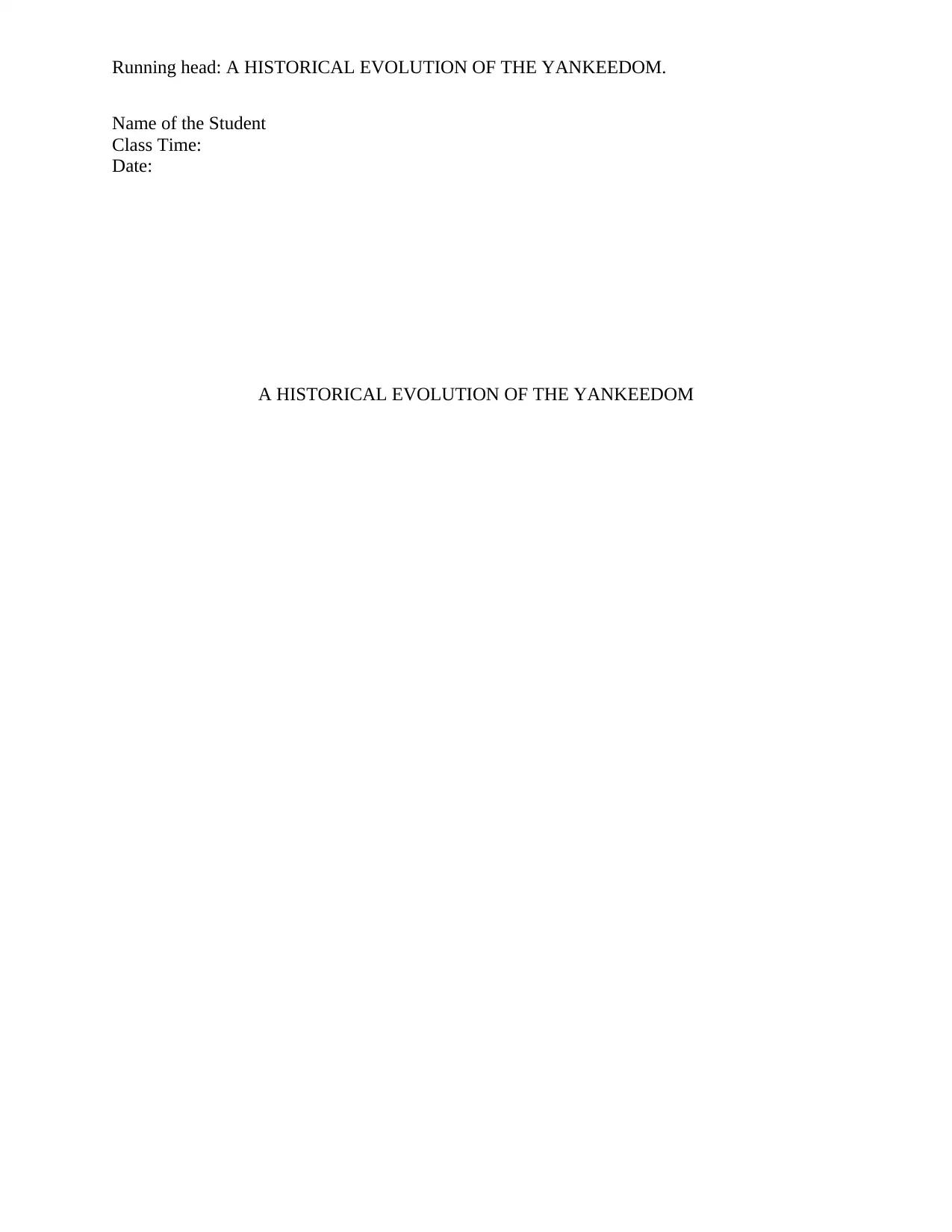
Running head: A HISTORICAL EVOLUTION OF THE YANKEEDOM.
Name of the Student
Class Time:
Date:
A HISTORICAL EVOLUTION OF THE YANKEEDOM
Name of the Student
Class Time:
Date:
A HISTORICAL EVOLUTION OF THE YANKEEDOM
Secure Best Marks with AI Grader
Need help grading? Try our AI Grader for instant feedback on your assignments.
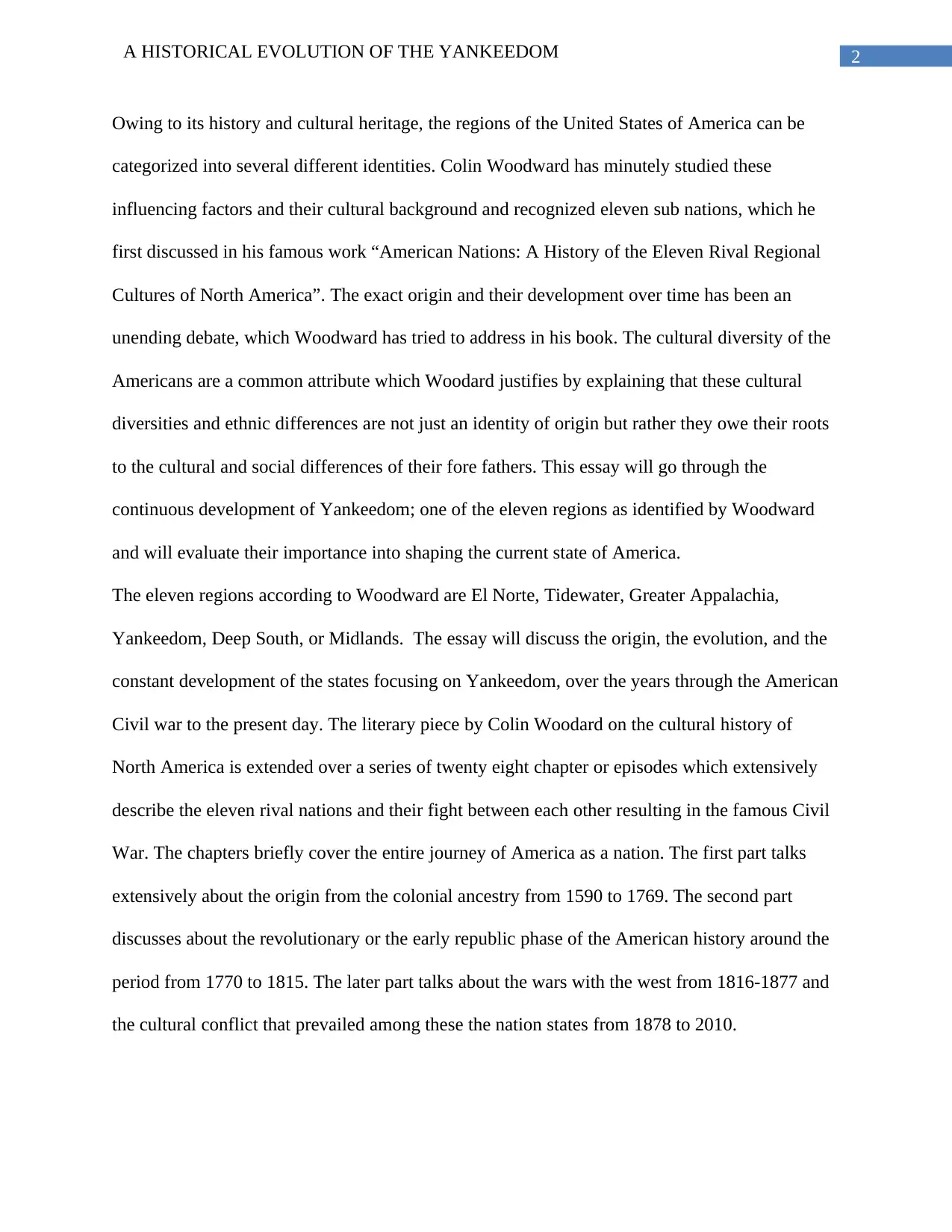
2A HISTORICAL EVOLUTION OF THE YANKEEDOM
Owing to its history and cultural heritage, the regions of the United States of America can be
categorized into several different identities. Colin Woodward has minutely studied these
influencing factors and their cultural background and recognized eleven sub nations, which he
first discussed in his famous work “American Nations: A History of the Eleven Rival Regional
Cultures of North America”. The exact origin and their development over time has been an
unending debate, which Woodward has tried to address in his book. The cultural diversity of the
Americans are a common attribute which Woodard justifies by explaining that these cultural
diversities and ethnic differences are not just an identity of origin but rather they owe their roots
to the cultural and social differences of their fore fathers. This essay will go through the
continuous development of Yankeedom; one of the eleven regions as identified by Woodward
and will evaluate their importance into shaping the current state of America.
The eleven regions according to Woodward are El Norte, Tidewater, Greater Appalachia,
Yankeedom, Deep South, or Midlands. The essay will discuss the origin, the evolution, and the
constant development of the states focusing on Yankeedom, over the years through the American
Civil war to the present day. The literary piece by Colin Woodard on the cultural history of
North America is extended over a series of twenty eight chapter or episodes which extensively
describe the eleven rival nations and their fight between each other resulting in the famous Civil
War. The chapters briefly cover the entire journey of America as a nation. The first part talks
extensively about the origin from the colonial ancestry from 1590 to 1769. The second part
discusses about the revolutionary or the early republic phase of the American history around the
period from 1770 to 1815. The later part talks about the wars with the west from 1816-1877 and
the cultural conflict that prevailed among these the nation states from 1878 to 2010.
Owing to its history and cultural heritage, the regions of the United States of America can be
categorized into several different identities. Colin Woodward has minutely studied these
influencing factors and their cultural background and recognized eleven sub nations, which he
first discussed in his famous work “American Nations: A History of the Eleven Rival Regional
Cultures of North America”. The exact origin and their development over time has been an
unending debate, which Woodward has tried to address in his book. The cultural diversity of the
Americans are a common attribute which Woodard justifies by explaining that these cultural
diversities and ethnic differences are not just an identity of origin but rather they owe their roots
to the cultural and social differences of their fore fathers. This essay will go through the
continuous development of Yankeedom; one of the eleven regions as identified by Woodward
and will evaluate their importance into shaping the current state of America.
The eleven regions according to Woodward are El Norte, Tidewater, Greater Appalachia,
Yankeedom, Deep South, or Midlands. The essay will discuss the origin, the evolution, and the
constant development of the states focusing on Yankeedom, over the years through the American
Civil war to the present day. The literary piece by Colin Woodard on the cultural history of
North America is extended over a series of twenty eight chapter or episodes which extensively
describe the eleven rival nations and their fight between each other resulting in the famous Civil
War. The chapters briefly cover the entire journey of America as a nation. The first part talks
extensively about the origin from the colonial ancestry from 1590 to 1769. The second part
discusses about the revolutionary or the early republic phase of the American history around the
period from 1770 to 1815. The later part talks about the wars with the west from 1816-1877 and
the cultural conflict that prevailed among these the nation states from 1878 to 2010.
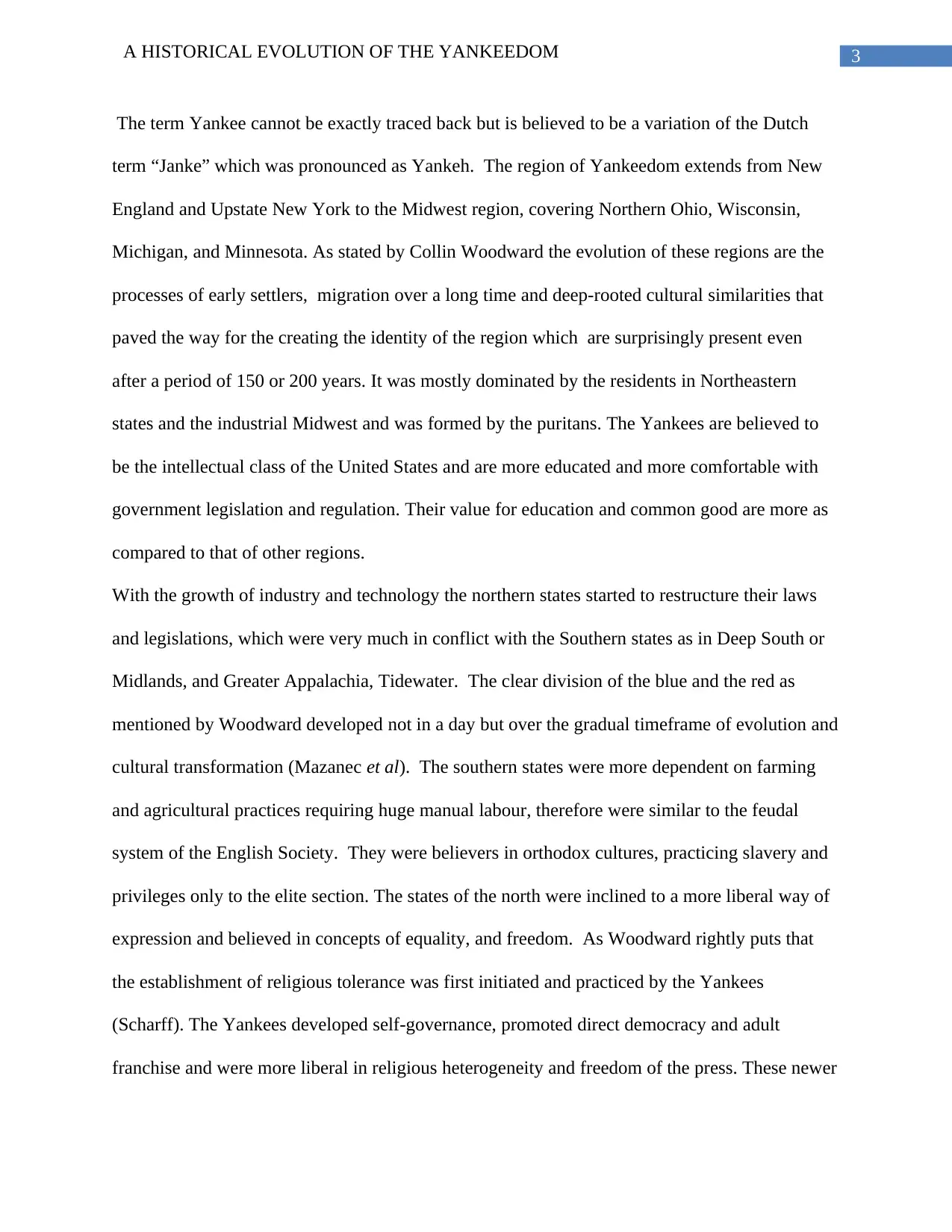
3A HISTORICAL EVOLUTION OF THE YANKEEDOM
The term Yankee cannot be exactly traced back but is believed to be a variation of the Dutch
term “Janke” which was pronounced as Yankeh. The region of Yankeedom extends from New
England and Upstate New York to the Midwest region, covering Northern Ohio, Wisconsin,
Michigan, and Minnesota. As stated by Collin Woodward the evolution of these regions are the
processes of early settlers, migration over a long time and deep-rooted cultural similarities that
paved the way for the creating the identity of the region which are surprisingly present even
after a period of 150 or 200 years. It was mostly dominated by the residents in Northeastern
states and the industrial Midwest and was formed by the puritans. The Yankees are believed to
be the intellectual class of the United States and are more educated and more comfortable with
government legislation and regulation. Their value for education and common good are more as
compared to that of other regions.
With the growth of industry and technology the northern states started to restructure their laws
and legislations, which were very much in conflict with the Southern states as in Deep South or
Midlands, and Greater Appalachia, Tidewater. The clear division of the blue and the red as
mentioned by Woodward developed not in a day but over the gradual timeframe of evolution and
cultural transformation (Mazanec et al). The southern states were more dependent on farming
and agricultural practices requiring huge manual labour, therefore were similar to the feudal
system of the English Society. They were believers in orthodox cultures, practicing slavery and
privileges only to the elite section. The states of the north were inclined to a more liberal way of
expression and believed in concepts of equality, and freedom. As Woodward rightly puts that
the establishment of religious tolerance was first initiated and practiced by the Yankees
(Scharff). The Yankees developed self-governance, promoted direct democracy and adult
franchise and were more liberal in religious heterogeneity and freedom of the press. These newer
The term Yankee cannot be exactly traced back but is believed to be a variation of the Dutch
term “Janke” which was pronounced as Yankeh. The region of Yankeedom extends from New
England and Upstate New York to the Midwest region, covering Northern Ohio, Wisconsin,
Michigan, and Minnesota. As stated by Collin Woodward the evolution of these regions are the
processes of early settlers, migration over a long time and deep-rooted cultural similarities that
paved the way for the creating the identity of the region which are surprisingly present even
after a period of 150 or 200 years. It was mostly dominated by the residents in Northeastern
states and the industrial Midwest and was formed by the puritans. The Yankees are believed to
be the intellectual class of the United States and are more educated and more comfortable with
government legislation and regulation. Their value for education and common good are more as
compared to that of other regions.
With the growth of industry and technology the northern states started to restructure their laws
and legislations, which were very much in conflict with the Southern states as in Deep South or
Midlands, and Greater Appalachia, Tidewater. The clear division of the blue and the red as
mentioned by Woodward developed not in a day but over the gradual timeframe of evolution and
cultural transformation (Mazanec et al). The southern states were more dependent on farming
and agricultural practices requiring huge manual labour, therefore were similar to the feudal
system of the English Society. They were believers in orthodox cultures, practicing slavery and
privileges only to the elite section. The states of the north were inclined to a more liberal way of
expression and believed in concepts of equality, and freedom. As Woodward rightly puts that
the establishment of religious tolerance was first initiated and practiced by the Yankees
(Scharff). The Yankees developed self-governance, promoted direct democracy and adult
franchise and were more liberal in religious heterogeneity and freedom of the press. These newer
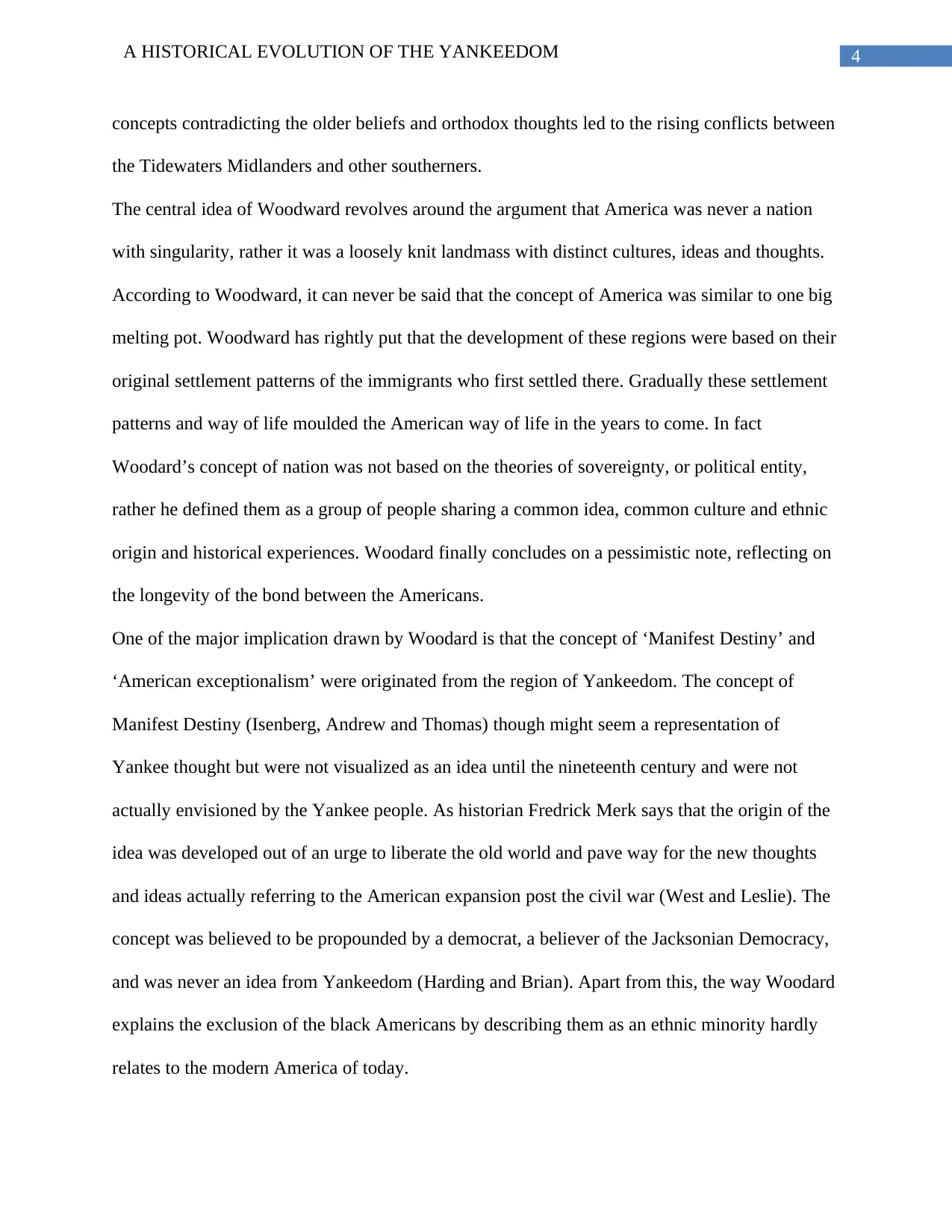
4A HISTORICAL EVOLUTION OF THE YANKEEDOM
concepts contradicting the older beliefs and orthodox thoughts led to the rising conflicts between
the Tidewaters Midlanders and other southerners.
The central idea of Woodward revolves around the argument that America was never a nation
with singularity, rather it was a loosely knit landmass with distinct cultures, ideas and thoughts.
According to Woodward, it can never be said that the concept of America was similar to one big
melting pot. Woodward has rightly put that the development of these regions were based on their
original settlement patterns of the immigrants who first settled there. Gradually these settlement
patterns and way of life moulded the American way of life in the years to come. In fact
Woodard’s concept of nation was not based on the theories of sovereignty, or political entity,
rather he defined them as a group of people sharing a common idea, common culture and ethnic
origin and historical experiences. Woodard finally concludes on a pessimistic note, reflecting on
the longevity of the bond between the Americans.
One of the major implication drawn by Woodard is that the concept of ‘Manifest Destiny’ and
‘American exceptionalism’ were originated from the region of Yankeedom. The concept of
Manifest Destiny (Isenberg, Andrew and Thomas) though might seem a representation of
Yankee thought but were not visualized as an idea until the nineteenth century and were not
actually envisioned by the Yankee people. As historian Fredrick Merk says that the origin of the
idea was developed out of an urge to liberate the old world and pave way for the new thoughts
and ideas actually referring to the American expansion post the civil war (West and Leslie). The
concept was believed to be propounded by a democrat, a believer of the Jacksonian Democracy,
and was never an idea from Yankeedom (Harding and Brian). Apart from this, the way Woodard
explains the exclusion of the black Americans by describing them as an ethnic minority hardly
relates to the modern America of today.
concepts contradicting the older beliefs and orthodox thoughts led to the rising conflicts between
the Tidewaters Midlanders and other southerners.
The central idea of Woodward revolves around the argument that America was never a nation
with singularity, rather it was a loosely knit landmass with distinct cultures, ideas and thoughts.
According to Woodward, it can never be said that the concept of America was similar to one big
melting pot. Woodward has rightly put that the development of these regions were based on their
original settlement patterns of the immigrants who first settled there. Gradually these settlement
patterns and way of life moulded the American way of life in the years to come. In fact
Woodard’s concept of nation was not based on the theories of sovereignty, or political entity,
rather he defined them as a group of people sharing a common idea, common culture and ethnic
origin and historical experiences. Woodard finally concludes on a pessimistic note, reflecting on
the longevity of the bond between the Americans.
One of the major implication drawn by Woodard is that the concept of ‘Manifest Destiny’ and
‘American exceptionalism’ were originated from the region of Yankeedom. The concept of
Manifest Destiny (Isenberg, Andrew and Thomas) though might seem a representation of
Yankee thought but were not visualized as an idea until the nineteenth century and were not
actually envisioned by the Yankee people. As historian Fredrick Merk says that the origin of the
idea was developed out of an urge to liberate the old world and pave way for the new thoughts
and ideas actually referring to the American expansion post the civil war (West and Leslie). The
concept was believed to be propounded by a democrat, a believer of the Jacksonian Democracy,
and was never an idea from Yankeedom (Harding and Brian). Apart from this, the way Woodard
explains the exclusion of the black Americans by describing them as an ethnic minority hardly
relates to the modern America of today.
Secure Best Marks with AI Grader
Need help grading? Try our AI Grader for instant feedback on your assignments.
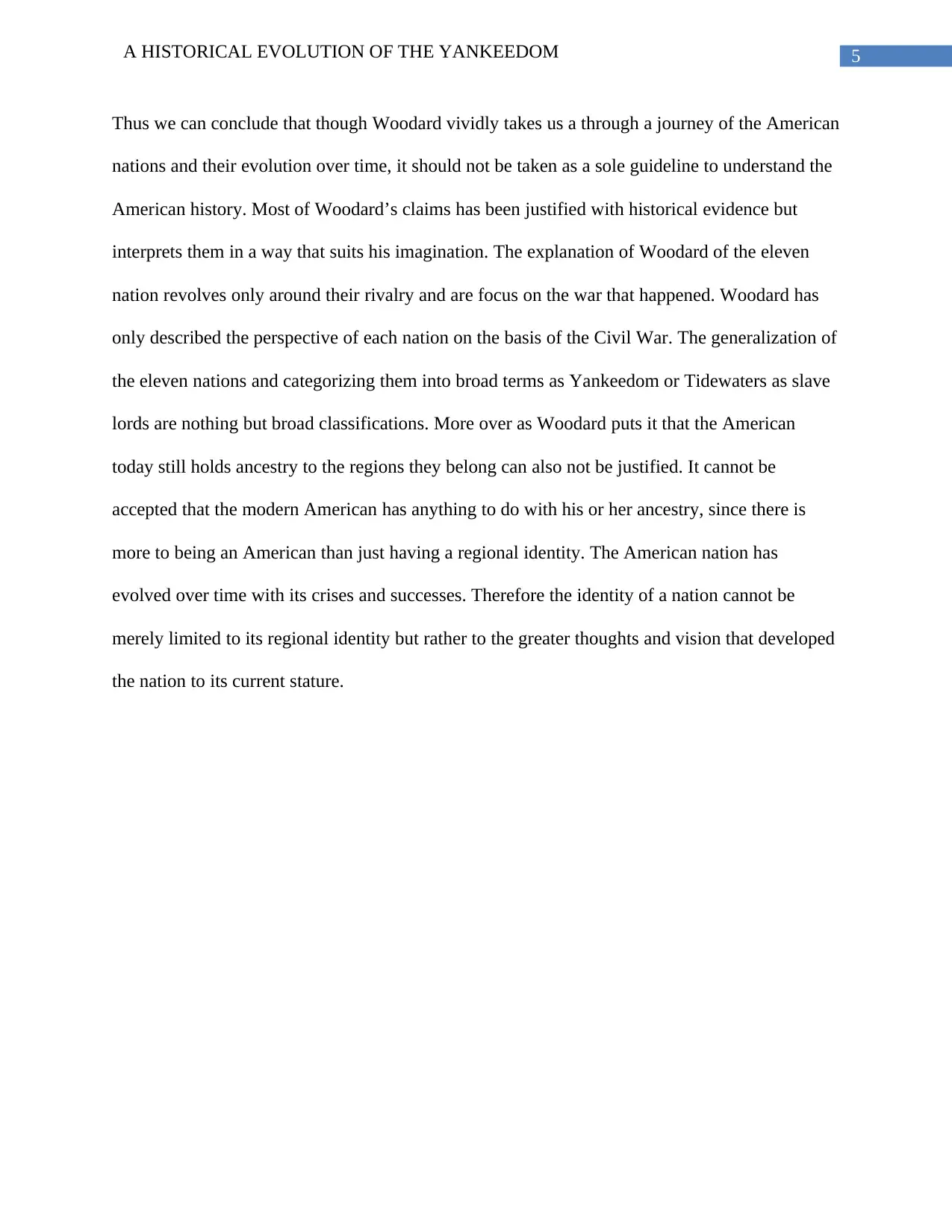
5A HISTORICAL EVOLUTION OF THE YANKEEDOM
Thus we can conclude that though Woodard vividly takes us a through a journey of the American
nations and their evolution over time, it should not be taken as a sole guideline to understand the
American history. Most of Woodard’s claims has been justified with historical evidence but
interprets them in a way that suits his imagination. The explanation of Woodard of the eleven
nation revolves only around their rivalry and are focus on the war that happened. Woodard has
only described the perspective of each nation on the basis of the Civil War. The generalization of
the eleven nations and categorizing them into broad terms as Yankeedom or Tidewaters as slave
lords are nothing but broad classifications. More over as Woodard puts it that the American
today still holds ancestry to the regions they belong can also not be justified. It cannot be
accepted that the modern American has anything to do with his or her ancestry, since there is
more to being an American than just having a regional identity. The American nation has
evolved over time with its crises and successes. Therefore the identity of a nation cannot be
merely limited to its regional identity but rather to the greater thoughts and vision that developed
the nation to its current stature.
Thus we can conclude that though Woodard vividly takes us a through a journey of the American
nations and their evolution over time, it should not be taken as a sole guideline to understand the
American history. Most of Woodard’s claims has been justified with historical evidence but
interprets them in a way that suits his imagination. The explanation of Woodard of the eleven
nation revolves only around their rivalry and are focus on the war that happened. Woodard has
only described the perspective of each nation on the basis of the Civil War. The generalization of
the eleven nations and categorizing them into broad terms as Yankeedom or Tidewaters as slave
lords are nothing but broad classifications. More over as Woodard puts it that the American
today still holds ancestry to the regions they belong can also not be justified. It cannot be
accepted that the modern American has anything to do with his or her ancestry, since there is
more to being an American than just having a regional identity. The American nation has
evolved over time with its crises and successes. Therefore the identity of a nation cannot be
merely limited to its regional identity but rather to the greater thoughts and vision that developed
the nation to its current stature.
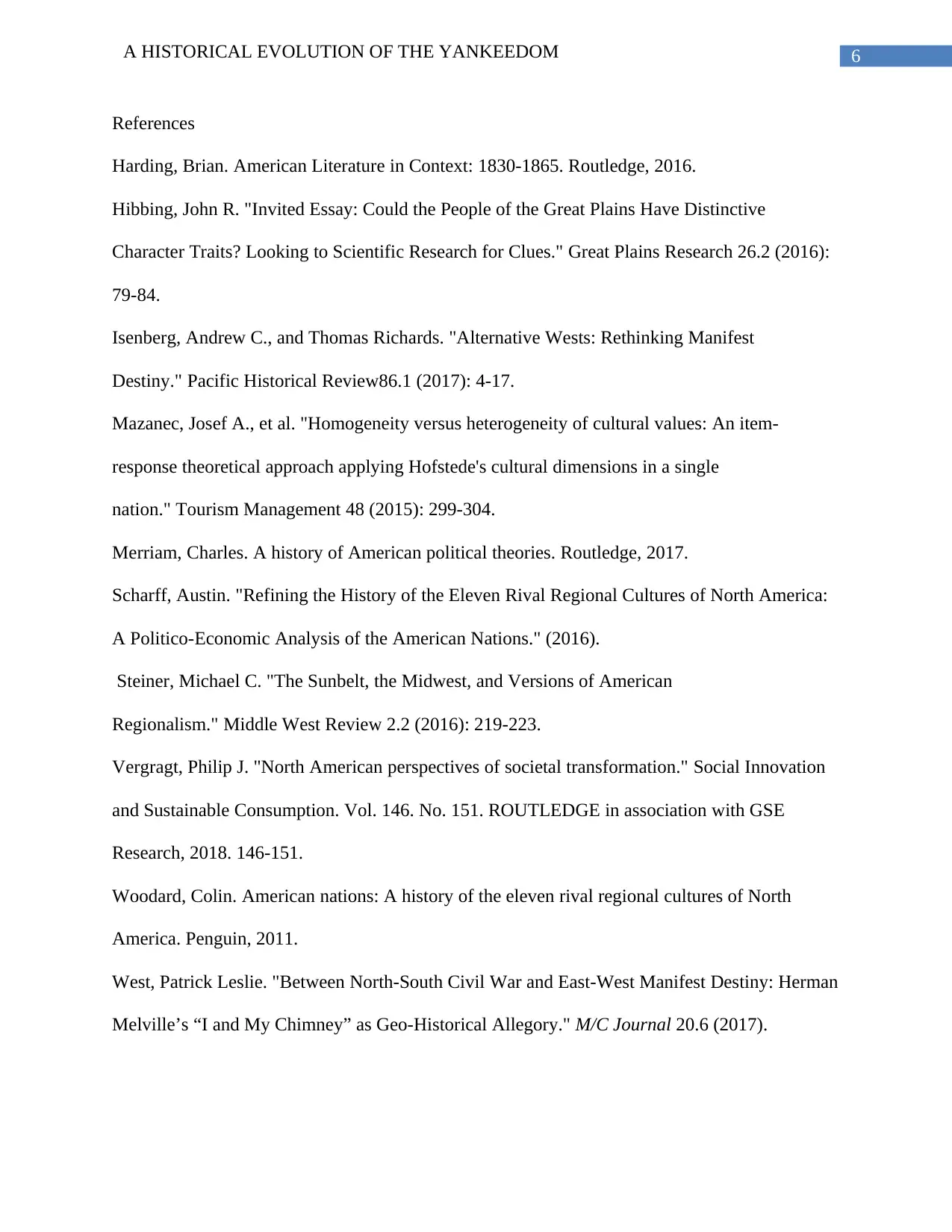
6A HISTORICAL EVOLUTION OF THE YANKEEDOM
References
Harding, Brian. American Literature in Context: 1830-1865. Routledge, 2016.
Hibbing, John R. "Invited Essay: Could the People of the Great Plains Have Distinctive
Character Traits? Looking to Scientific Research for Clues." Great Plains Research 26.2 (2016):
79-84.
Isenberg, Andrew C., and Thomas Richards. "Alternative Wests: Rethinking Manifest
Destiny." Pacific Historical Review86.1 (2017): 4-17.
Mazanec, Josef A., et al. "Homogeneity versus heterogeneity of cultural values: An item-
response theoretical approach applying Hofstede's cultural dimensions in a single
nation." Tourism Management 48 (2015): 299-304.
Merriam, Charles. A history of American political theories. Routledge, 2017.
Scharff, Austin. "Refining the History of the Eleven Rival Regional Cultures of North America:
A Politico-Economic Analysis of the American Nations." (2016).
Steiner, Michael C. "The Sunbelt, the Midwest, and Versions of American
Regionalism." Middle West Review 2.2 (2016): 219-223.
Vergragt, Philip J. "North American perspectives of societal transformation." Social Innovation
and Sustainable Consumption. Vol. 146. No. 151. ROUTLEDGE in association with GSE
Research, 2018. 146-151.
Woodard, Colin. American nations: A history of the eleven rival regional cultures of North
America. Penguin, 2011.
West, Patrick Leslie. "Between North-South Civil War and East-West Manifest Destiny: Herman
Melville’s “I and My Chimney” as Geo-Historical Allegory." M/C Journal 20.6 (2017).
References
Harding, Brian. American Literature in Context: 1830-1865. Routledge, 2016.
Hibbing, John R. "Invited Essay: Could the People of the Great Plains Have Distinctive
Character Traits? Looking to Scientific Research for Clues." Great Plains Research 26.2 (2016):
79-84.
Isenberg, Andrew C., and Thomas Richards. "Alternative Wests: Rethinking Manifest
Destiny." Pacific Historical Review86.1 (2017): 4-17.
Mazanec, Josef A., et al. "Homogeneity versus heterogeneity of cultural values: An item-
response theoretical approach applying Hofstede's cultural dimensions in a single
nation." Tourism Management 48 (2015): 299-304.
Merriam, Charles. A history of American political theories. Routledge, 2017.
Scharff, Austin. "Refining the History of the Eleven Rival Regional Cultures of North America:
A Politico-Economic Analysis of the American Nations." (2016).
Steiner, Michael C. "The Sunbelt, the Midwest, and Versions of American
Regionalism." Middle West Review 2.2 (2016): 219-223.
Vergragt, Philip J. "North American perspectives of societal transformation." Social Innovation
and Sustainable Consumption. Vol. 146. No. 151. ROUTLEDGE in association with GSE
Research, 2018. 146-151.
Woodard, Colin. American nations: A history of the eleven rival regional cultures of North
America. Penguin, 2011.
West, Patrick Leslie. "Between North-South Civil War and East-West Manifest Destiny: Herman
Melville’s “I and My Chimney” as Geo-Historical Allegory." M/C Journal 20.6 (2017).
1 out of 6
Your All-in-One AI-Powered Toolkit for Academic Success.
+13062052269
info@desklib.com
Available 24*7 on WhatsApp / Email
![[object Object]](/_next/static/media/star-bottom.7253800d.svg)
Unlock your academic potential
© 2024 | Zucol Services PVT LTD | All rights reserved.

